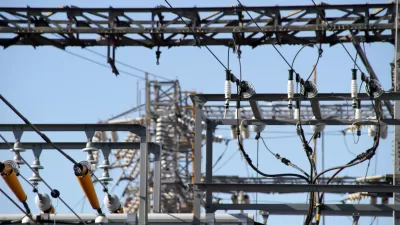An example from St. Louis County shows one way that sprawl is subsidized by areas closer to the regional center.

Richard Bose makes a point about the relative costs of utilities like water and electricity, depending on whether you live in the sprawling reaches of a region or closer to the dense urban core: "for the same amount of usage, households closer together subsidize households further apart."
The inequity occurs because utilities don't charge for the length or the size of infrastructure, and Bose has an obvious example from the St. Louis region to prove that point.
Missouri American Water has 4,200 miles of water mains and 31,000 fire hydrants in St. Louis County. Bills are calculated with the sum of a minimum customer charge based on water meter diameter and usage (MO American Water rates).
Like many other water systems around the country, the infrastructure that Missouri American Water and its users rely on has reached the end of its useful life.
Recognizing the need to replace old pipes, the Missouri Legislature authorized Missouri American Water to charge customers for infrastructure replacement in 2003. Missouri American Water added a fee on bills called the Infrastructure System Replacement Surcharge (ISRS). Since its inception, MO American Water has spent $445 million on improvements to water distribution and hydrant upgrades in St. Louis County.
With no consideration given to the amount of the infrastructure need to supply water to customers, the rate instead applies a universal charge of $0.7642 per 1000 gallons of water. Bose does the math to discover the winners and losers under that fee structure (read the full article for the details), also finding that the rate is likely much to low to pay for existing and future costs.
FULL STORY: How We Subsidize Spread-out Places Via Utilities

Alabama: Trump Terminates Settlements for Black Communities Harmed By Raw Sewage
Trump deemed the landmark civil rights agreement “illegal DEI and environmental justice policy.”

Planetizen Federal Action Tracker
A weekly monitor of how Trump’s orders and actions are impacting planners and planning in America.

The 120 Year Old Tiny Home Villages That Sheltered San Francisco’s Earthquake Refugees
More than a century ago, San Francisco mobilized to house thousands of residents displaced by the 1906 earthquake. Could their strategy offer a model for the present?

In Both Crashes and Crime, Public Transportation is Far Safer than Driving
Contrary to popular assumptions, public transportation has far lower crash and crime rates than automobile travel. For safer communities, improve and encourage transit travel.

Report: Zoning Reforms Should Complement Nashville’s Ambitious Transit Plan
Without reform, restrictive zoning codes will limit the impact of the city’s planned transit expansion and could exclude some of the residents who depend on transit the most.

Judge Orders Release of Frozen IRA, IIJA Funding
The decision is a victory for environmental groups who charged that freezing funds for critical infrastructure and disaster response programs caused “real and irreparable harm” to communities.
Urban Design for Planners 1: Software Tools
This six-course series explores essential urban design concepts using open source software and equips planners with the tools they need to participate fully in the urban design process.
Planning for Universal Design
Learn the tools for implementing Universal Design in planning regulations.
Clanton & Associates, Inc.
Jessamine County Fiscal Court
Institute for Housing and Urban Development Studies (IHS)
City of Grandview
Harvard GSD Executive Education
Toledo-Lucas County Plan Commissions
Salt Lake City
NYU Wagner Graduate School of Public Service





























